XXVIII - Mediastinal Infections, Overview of Mass Lesions in the Mediastinum, and Control of Vascular Obstructing Symptomatology
Editors: Shields, Thomas W.; LoCicero, Joseph; Ponn, Ronald B.; Rusch, Valerie W.
Title: General Thoracic Surgery, 6th Edition
Copyright 2005 Lippincott Williams & Wilkins
> Table of Contents > Volume II > The Mediastinum > Section XXX - Mediastinal Cysts > Chapter 195 - Foregut Cysts of the Mediastinum
Chapter 195
Foregut Cysts of the Mediastinum
Jocelyne Martin
Jean Deslauriers
Andr C.H. Duranceau
Mediastinal cysts are common lesions encountered in children and adults. Most are congenital lesions and, according to Silverman and Sabiston (1980) and Oldham and Sabiston (1967), they account for 20% to 32% of all primary masses of the mediastinum. Despite the frequent discovery of these cysts in infancy and childhood, one half or more of these cysts are not identified until the third or fourth decade of life. In our experience, reported by St-Georges and associates (1991), when regrouping all cystic lesions of the mediastinum found in nonpediatric university-affiliated hospitals, 32% of all cysts were found in patients under 20 years of age, whereas 68% were in patients over 20 years of age.
CLASSIFICATION OF MEDIASTINAL CYSTS
The classification of mediastinal cysts usually is based on their etiology (Table 195-1). Foregut cysts are the result of an abnormal budding or division of the primitive foregut. Also called enterogenous cysts, they are most frequently divided into categories based on their histologic features and embryogenesis.
Bronchogenic cysts occur mostly along the tracheobronchial tree and are found usually behind the carina. Most often they are unilocular and lined by ciliated columnar epithelium with focal or extensive squamous metaplasia. Rosai (1989), Coulson (1978), Sternberg (1989), and Marchevsky and Kaneko (1984) have described how their walls may contain hyaline cartilage, smooth muscle, bronchial glands, and nerve trunks. Bronchogenic cysts account for 50% to 60% of mediastinal cysts and are usually found in adults. They can be intrapulmonary or extrapulmonary and rarely show a communication with the airway. These cysts may extend below the diaphragm as dumbbell cysts.
Esophageal cysts are less common than bronchogenic lesions, and they are characterized by a double layer of smooth muscle in their walls. Most of them are found embedded in the wall of the lower half of the esophagus. Their lining may be squamous, ciliated columnar, or a mixture of both. Distinction from bronchial cysts may be difficult or even impossible, and the best evidence in favor of their esophageal etiology is when they are totally within the esophageal wall and covered by a definite double layer of smooth muscle. They are usually not in communication with the esophageal lumen. Two theories are suggested by Abel (1956), Coulson (1978), Marchevsky and Kaneko (1984), Rosai (1989), and Sternberg (1989) to explain the development of esophageal cysts: persistent vacuoles in the wall of the foregut, an abnormal budding from the foregut, or both.
This chapter focuses on the most common cystic lesions encountered in the mediastinum of the adult. These are the bronchogenic and the esophageal cysts of the foregut.
BRONCHOGENIC CYSTS
Embryogenesis
The bronchogenic foregut cysts are believed to result from sequestration of cells from the region of the laryngotracheal groove during early embryologic development.
P.2831
During the third week of gestation, the laryngotracheal groove or primitive respiratory system develops as a ventral diverticulum located in the floor of the foregut, just caudal to the pharyngeal pouches. This diverticulum later transforms into a tube that becomes the primitive bronchial tree. After the fourth week, two enlargements develop distally, and these become the future bronchial and lung buds. By the 35th day, the lobar bronchi appear.
Table 195-1. Classification of Mediastinal Cysts | |
|---|---|
|
Abnormal budding of the bronchial tree may lead to abnormal tracheal and bronchial cystic masses called bronchogenic cysts. When this abnormal budding occurs early during gestation, the cysts tend to be located within the mediastinum and seldom communicate with the bronchial tree. Cysts that arise later during development are more peripheral and are located within the lung parenchyma. These intraparenchymal cysts often have a bronchial communication.
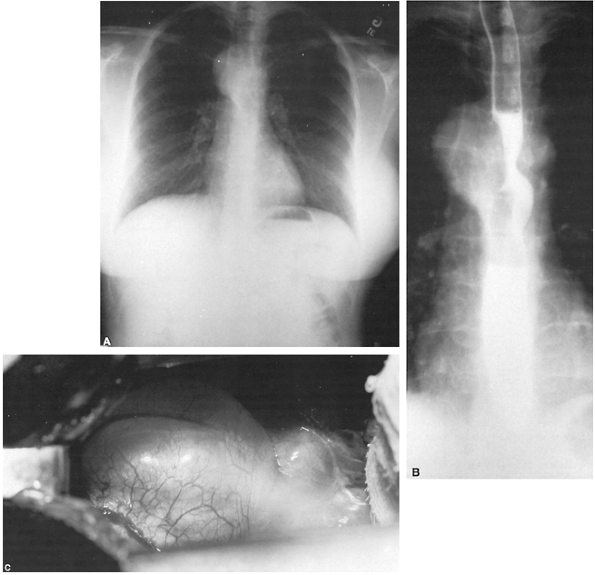 |
Fig. 195-1. A. Chest radiograph reveals a large, round, homogeneous mass located in the right paratracheal area. B. Compression of the esophagus shown on barium swallow. C. Operative photograph shows a spheric cystic mass covered by a smooth, intact capsule. |
The majority of the bronchogenic cysts are in close anatomic relationship with the tracheobronchial tree (Fig. 195-1) or the esophagus (Fig. 195-2) in the visceral compartment of the mediastinum. Bronchogenic cysts occasionally may even extend below the diaphragm as a dumbbell cyst. Amendola and colleagues (1982) reviewed nine cases of dumbbell cysts reported in the literature and added one of their own discovered in this latter location. Coselli and associates (1987) described a bronchogenic cyst located wholly within the abdomen in the region of the tail of the pancreas.
P.2832
Three other similarly located cysts have been described by Miller (1953) and Sumiyoshi (1985) and their colleagues, as well as by Murley and Lenz (1979).
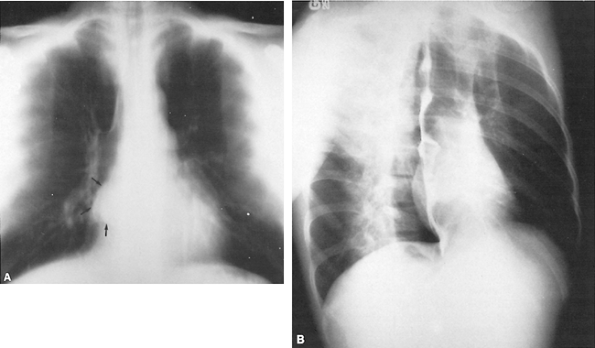 |
Fig. 195-2. A. Posteroanterior chest radiograph of a young man with severe chest pain reveals a right-sided retrocardiac mass (arrows). B. A barium swallow reveals some degree of compression of the lower fourth of the esophagus. The mass proved to be a bronchogenic cyst on excision. |
As noted, cysts developing late in the course of embryologic development may be located within the parenchyma of the lung and in the adult represent approximately 25% of all bronchogenic cysts.
Pathology
Bronchogenic cysts are most often spheric, unilocular, cystic masses in contact with the tracheobronchial tree. Infrequently, the cysts may be lobulated, multiloculated, or, rarely, multiple. They may be located near or within the wall of the esophagus, in the lung, or even within the pericardial sac. Maier (1948) divided their location into five groups: paratracheal, carinal, hilar, paraesophageal, and miscellaneous. In our experience, when using the tracheobronchial bifurcation as a dividing line, 23% of the cysts are located in the superior portion of the chest, whereas 77% of the lesions are below the tracheal carina. Roughly one third were in the middle mediastinum, whereas the other two thirds extended to the limits of the posterior portion of the mediastinum and even to the paravertebral area (Fig. 195-3). The fifth group, miscellaneous, are located in abnormal locations. These latter cysts include those in the anterior mediastinal compartment, the pericardial cavity, paravertebral sulcus, the aforementioned dumbbell cysts, and those located in the abdomen.
P.2833
Coselli and associates (1987) suggested that these latter cysts possibly arise from abnormal budding of the primitive foregut that migrates into the abdomen before fusion of the pleuroperitoneal membranes. Buddington (1957) reported one located within the diaphragm. Magnussen (1977) and Dubois (1981) and their associates reported a bronchogenic cyst in the presternal area and supraclavicular spaces, respectively. Gomes and Hufnagel (1975), among others, reported an intrapericardial location. In the series collected by us, the location of the 86 bronchogenic cysts was mediastinal in 66 patients and intrapulmonary in 20.
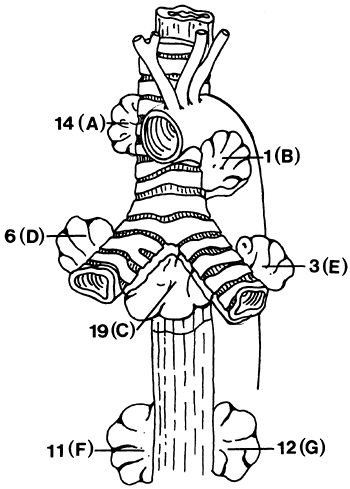 |
Fig. 195-3. Anatomic location of mediastinal bronchogenic cysts according to Maier's classification. (A) right paratracheal; (B) left paratracheal; (C) subcarinal; (D) right hilar; (E) left hilar; (F) right paraesophageal; (G) left paraesophageal. From St-Georges R, et al: Clinical spectrum of bronchogenic cysts of the mediastinum and lung in the adult. Ann Thorac Surg 52:6, 1991. With permission. |
As observed by Sulzer and associates (1970) in their series of 40 bronchogenic cysts, more than 85% of these are in close association with either the tracheobronchial tree or the esophagus. Two thirds of these cysts were located in a paratracheal or subcarinal location; the remaining one third was paraesophageal in location in the lower half of the chest.
The cysts contain a whitish gray mucinous material but may contain brownish inspissated material. The common lining is a single layer of respiratory epithelium-ciliated columnar cells (Fig. 195-4). The layer of cells may be cuboidal or may be a simple flattened epithelial layer. Varying degrees of squamous metaplasia can be present. A lamina propria may contain bronchial glands, connective and smooth muscle tissue, and cartilage. At times in the presence of infection, the cyst may contain frank pus. With infection, the epithelial layer lining the cyst may be absent (Fig. 195-5).
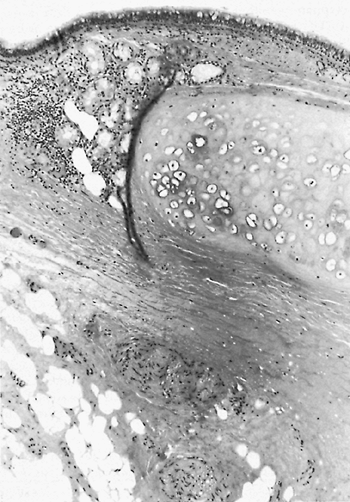 |
Fig. 195-4. Photomicrograph of the wall of the bronchogenic cyst shown in Fig. 195-1 reveals the internal surface lined by characteristic respiratory epithelium. A cartilaginous plate is present beneath the mucosal lining. |
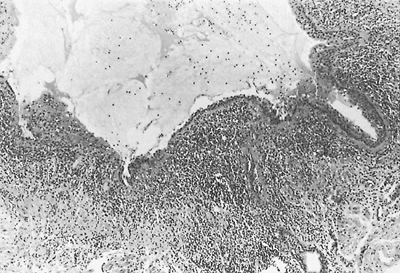 |
Fig. 195-5. Photomicrograph of wall of the resected infected bronchogenic cyst shown in Fig. 195-2 with absence of a portion of the mucosal lining as a result of the inflammatory process. |
Clinical Features
Bronchogenic cysts are found somewhat more often in men than in women, although in our series the ratio was reversed. Many in the adult are asymptomatic, but contrary to a widely held belief, as espoused by Maier (1948) and Wychulis and associates (1971), well over half are, or will become, symptomatic because of compression of the airway or the esophagus or the presence of infection. The latter may be caused by perforation into either of the former structures, but the infection most often occurs without such a communication.
In the series reported by Sirivella and associates (1985) that included individuals with nonspecific and enterogenous cysts; 16 of 20 patients were symptomatic and the most common complaints were cough, dyspnea, dysphagia, and chest pain.
In our series published by St-Georges and co-workers (1991), 66.6% of the patients with mediastinal bronchogenic cysts were symptomatic and the majority (two thirds) had two or more symptoms. These are summarized in Tables 195-2 and 195-3. When the cyst is in the mediastinum, substernal pain is the most common symptom. This is likely the result of irritation or inflammation of the surrounding parietal or mediastinal pleura. Dysphagia, dyspnea, and cough are all caused by compression or irritation of bronchi or esophagus by the cyst. Expectoration of purulent sputum is seen in 7.5% of the mediastinal cysts and indicate either infection of the cyst with fistulization or, more likely, pneumonia in the adjacent compressed lung. Actually, 26 of 66 (39.3%) of our patient population were observed conservatively and 15 of 26 (57.6%)
P.2834
developed symptoms while the abnormal mass was being observed conservatively. If a complication occurs in a radiologically detected cyst located in the mediastinum, nearly one third of these patients still remain asymptomatic. These lesions may then lead to further difficulties.
Table 195-2. Incidence of Symptoms Associated with Mediastinal Bronchogenic Cysts | ||||||||||
|---|---|---|---|---|---|---|---|---|---|---|
| ||||||||||
Complications
Eighteen patients (27%) had a complicated cyst, as documented by gross and histopathologic examination, but in none of them did this complication result in a major illness (Table 195-4). Inflammation of the cyst wall with or without mucosal ulcerations was observed in 18% of the patients, and this finding was often associated with chest pain. True cyst infection with positive bacteriology was uncommon, and frank communication with the tracheobronchial tree was documented in three patients who presented with dyspnea, fever, and productive cough. Communication with the esophagus or the pericardial cavity was not observed.
Cardiovascular complications are seldom seen in association with mediastinal bronchogenic cysts. Watson and Chaudhary (1987) cited a patient with ventricular and atrial tachycardia believed to be caused by compression by the cyst. Similarly, Volpi and associates (1988) reported the occurrence of paroxysmal atrial fibrillation as the presenting feature of a bronchogenic cyst impinging on the atrium. Watts (1984) and Berkowitz (1988) and their colleagues described compression of the pulmonary artery simulating arterial stenosis, and Selke and associates (1975) described long-standing pulmonary artery compression resulting in pulmonary artery hypoplasia and hyperlucent lung (Fig. 195-6). Superior vena cava syndrome also has been described in association with bronchogenic cysts.
Table 195-3. Symptoms Associated with Mediastinal Bronchogenic Cysts | ||||||||||||||||||||||||||||||||||||||
|---|---|---|---|---|---|---|---|---|---|---|---|---|---|---|---|---|---|---|---|---|---|---|---|---|---|---|---|---|---|---|---|---|---|---|---|---|---|---|
| ||||||||||||||||||||||||||||||||||||||
Table 195-4. Complications in Bronchogenic Cysts of Mediastinum | ||||||||||||||||||
|---|---|---|---|---|---|---|---|---|---|---|---|---|---|---|---|---|---|---|
| ||||||||||||||||||
A single patient in our series presented with hemorrhage within the cyst. Malignant transformation of the cyst wall was not seen in our experience.
Cysts lined by gastric epithelium occasionally may be seen with symptoms related to acid secretion within the cyst. Peptic ulceration with cyst perforation, as reported by Moor and Jahnke (1957), may occur. Bronchial communication was reported by Overton and Oberstreet (1958), and Spock and colleagues (1966) described the occurrence of hemorrhage from the cyst. In such cases, hematemesis or hemoptysis may be the presenting symptom.
Radiographic Features
Standard Radiographic Studies
Reed and Sobonya (1974) reviewed the radiographic features in 80 patients with foregut cysts; 77% to 87% of these were bronchogenic. Almost all were spheroid masses in the visceral compartment of the mediastinum (86%), and the remaining (14%) were intrapulmonary in location. Most were right sided (70%). Thirty-two percent were superior (paratracheal in location) to the tracheal carina, and 68% were located below the level of the carina (Fig. 195-7). Calcification was occasionally seen peripherally, within the wall, but never within the cyst itself. Air or an air fluid level was seen in four (5.6%) of the bronchogenic cysts. Distention
P.2835
or distortion of the esophagus demonstrated on the esophagram can be present depending on the location and size of the cyst. It may be difficult to differentiate the cyst from a benign esophageal tumor such as a leiomyoma. In approximately half of the patients, whether symptomatic or not, some degree of esophageal displacement is noted.
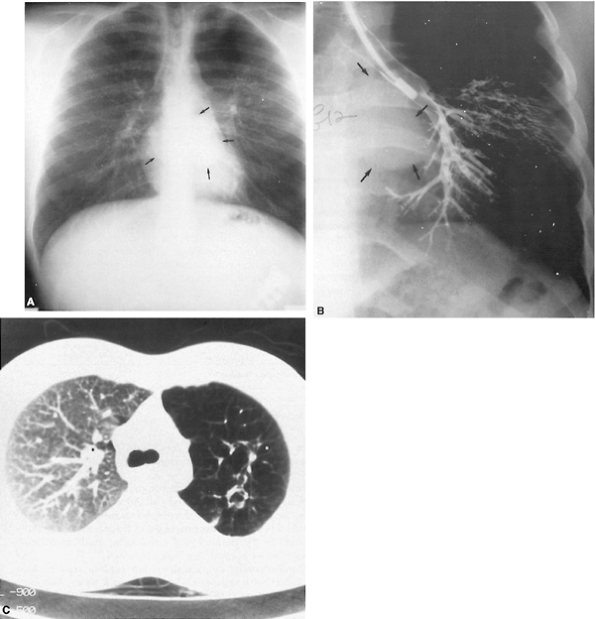 |
Fig. 195-6. A. Chest radiograph in an asymptomatic young man reveals a rounded retrocardiac mass (arrows) associated with hyperlucency of the left upper lobe. B. Selective bronchogram demonstrates the mass (arrows) with normal but compressed upper lobe bronchi. C. CT scan (lung window) reveals marked hyperlucency of the left upper lobe. |
Computed Tomography and Magnetic Resonance Imaging
A computed tomographic (CT) scan most often reveals the cystic nature of the lesion (Fig. 195-8). Nakata and colleagues (1982) have described the characteristic features of these cysts. These researchers, as well as Jost (1978) and Mendelson (1983) and their associates, noted that many of the bronchogenic cysts have high Hounsfield numbers approaching those of soft tissue masses rather than the low density of water, so that a CT scan is not absolute in demonstrating the characteristic features of a fluid-filled cystic lesion. Calcification of portions of the cystic wall may be demonstrated frequently, which is not appreciated on the standard radiographic examination. In addition to scanning the chest, one should always scan the upper abdomen to document a possible extension of the cyst below the diaphragm.
 |
Fig. 195-7. A, B. Typical posteroanterior and lateral radiographic appearance of a subcarinal bronchogenic cyst. |
P.2836
Magnetic resonance (MR)imaging can help in the investigation of a bronchogenic cyst, especially in a lesion with a high Hounsfield number in which the fluid-filled cystic nature of the lesion is in doubt. An intense signal on T2-weighted magnetic resonance imaging (Fig. 195-9) may support the interpretation of a fluid-containing structure in such a situation. The typical high-intensity signal of a fluid-filled bronchogenic cyst has been noted by K nig and Herold (1986), by LeBlanc and co-workers (1994), and by Kanemitsu and associates (1999). Imaging in a coronal or sagittal plane is also possible (Fig. 195-10).
Ultrasonography can be useful to demonstrate the cystic nature of the lesion and whether the cyst creates some distortion of the cardiac chambers or great vessels. Anderson and colleagues (1982) and Watson and Chaudhary (1987) have shown that for some patients, ultrasonography may obviate the need for more invasive modalities, such as angiography. More recently, endoscopic ultrasonography has helped differentiate bronchogenic cysts from solid lesions, as shown by Lim and colleagues (2002).
 |
Fig. 195-8. Computed tomographic scan (mediastinal window) of the mass shown in Fig. 195-6 reveals a smooth, well-circumscribed, posteriorly located left perihilar fluid-filled cystic structure typical of a bronchogenic cyst. |
Diagnostic Investigation
Depending on the cyst's location or the presence of symptomatology, bronchoscopy or esophagoscopy, or both, can be indicated. Mediastinoscopy is not necessary, nor is needle aspiration of the cyst warranted, as has been advocated by Zimmer and associates (1986).
Angiography should almost never be required except for differentiating a bronchogenic cyst from an extralobar sequestration or for diagnosing a lesion originating from the heart or large vessels. Similarly, radionuclide scans have little use in the investigation of foregut cysts of the mediastinum. Salyer and colleagues (1977) noted in one patient an increased tracer activity (technetium 99m sodium pertechnetate) in areas of gastric activity within an enterogenous cyst. Berkowitz and associates (1988) also noted hypoperfusion of the right lung as documented by perfusion scan in a patient with a subcarinal bronchogenic cyst compressing the pulmonary artery.
Treatment
Rationale for Surgical Excision
Even in the absence of symptoms, surgical exploration is recommended for nearly all patients with an abnormal mediastinal
P.2837
mass, as documented by radiographic studies (Table 195-5). This approach is not only required to establish definitive tissue diagnosis but also to alleviate symptoms and prevent complications. This is especially true with mediastinal bronchogenic cysts in which 66% of them are or will ultimately become symptomatic, complicated (27%), or both.
 |
Fig. 195-9. A. T1-weighted magnetic resonance image of the mass shown in Fig. 195-6 demonstrates the lesion to be of intermediate intensity. B. T2-weighted image reveals a typical hyperintense signal of a fluid-filled structure. Excision and pathologic examination of the mass revealed it to be a bronchogenic cyst. |
In our series, 26 patients were previously known to have a mediastinal mass and in 57.6% of them, surgery became necessary either because the mass had enlarged or had become symptomatic during the period of follow-up (see Fig. 195-5). Of the 40 patients with the newly discovered disease, 28 were symptomatic, 11 had lesions detected during examinations for unrelated illnesses, and 1 case was identified at the time of surgery for reflux esophagitis. Overall, the correct diagnosis of a bronchogenic cyst was made preoperatively in only 35% of our cases. However, only two patients had undergone MR imaging, and one fourth of the patients had undergone CT scan preoperatively. Other diagnoses entertained before surgery were those of neurogenic tumors, pericardial cysts, and lymphomas.
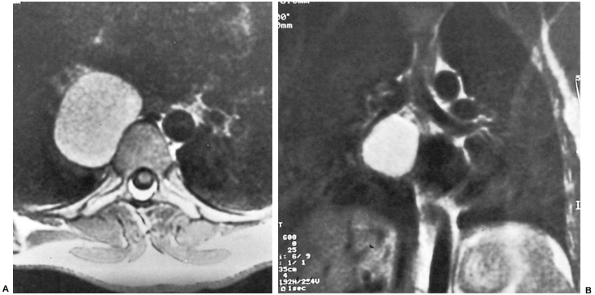 |
Fig. 195-10. Magnetic resonance image of bronchogenic cyst shown in Fig. 195-7. T2-weighted cross-sectional image (A) and coronal image (B). Note narrowing of the bronchus intermedius. |
The risk for malignancy developing in a mediastinal bronchogenic cyst is minute, although carcinomas and fibrosarcomas have been reported to have developed in a bronchogenic cyst. However, Marchevsky and Kaneko (1984) stated that the occurrence of a carcinoma in a bronchogenic cyst has not been described satisfactorily to their knowledge. Nonetheless, a potentially malignant bronchial adenoma was reported in a cyst by Greenfield and Howe (1965), and Bennheim and associates (1980) described a leiomyosarcoma that they believed had developed within the wall of a bronchogenic cyst.
Far more important and serious than the minute risk of malignancy are the risks of complications of infection or perforation developing in the cyst, thus rendering excision potentially more difficult and hazardous.
Surgical Technique
The surgical approach used to be mostly through a posterolateral thoracotomy (93% of cases in our series). Cysts located at the level of the thoracic inlet are best approached
P.2838
by exposing the mediastinum with a proximal sternotomy extending into the neck on the side of the documented lesion. Paratracheal lesions are approached through the appropriately sided thoracotomy; subcarinal cysts are best exposed through a right-sided thoracotomy, as are most of the paraesophageal cysts in the lower half of the chest. Total enucleation of the cyst is the procedure of choice. Complete excision is possible in nearly all cases, whether the cyst is complicated or not. One of our patients, similar to the one reported by Ginsberg and colleagues (1972), had a subcarinal bronchogenic cyst successfully resected through a mediastinoscopy incision, although in Ginsberg's patient only aspiration of the cyst was performed.
Table 195-5. Indications for Surgery in 66 Patients with Bronchogenic Cysts of the Mediastinum | ||||||||||||||||||
|---|---|---|---|---|---|---|---|---|---|---|---|---|---|---|---|---|---|---|
| ||||||||||||||||||
The development of video-assisted thoracic surgery has brought a new approach to diagnose and treat mediastinal cysts. Video-assisted thoracic surgical resection or excision of mediastinal bronchogenic and esophageal cysts has been reported by Demmy (1998), Lewis (1992), and Bonavina (1996) and their co-workers, as well as by Yim (1995). Results of 20 cases have also been published by Martinod and co-workers (2000). The potential advantages are decreased pain, a shorter hospital stay, and a rapid return to normal activity. Drawbacks are limited exposure because of the large size or position of the cyst and less than complete excision resulting in recurrences or complications related to the remaining mucosa.
In a significant proportion of cases, the cyst is closely adherent to adjacent organs, such as the tracheobronchial tree (52%), esophagus (47%), pericardium (30%), or lung (20%), but these adhesions do not usually preclude complete excision of the cyst. When total removal is difficult or not possible, the mucosa of the cyst may have to be peeled away from the attached structure, leaving behind the nonepithelial portions of the cyst wall. This may prevent a recurrence such as described by Walker (1978) and Miller (1978) and their associates.
A watch and wait attitude in a patient with a mediastinal cyst, even if asymptomatic, is not recommended. Estrera and associates (1987) strongly support the concept of surgical excision once the cyst has been identified, and this attitude is seen as the only policy capable of preventing complications. Transbronchial needle aspiration (TBNA), described by Cohn and associates (1987), and percutaneous aspiration, reported by Zimmer and colleagues (1986), have been proposed as an alternative to thoracotomy in symptomatic patients with benign mediastinal cysts. Aspiration of the cyst is not recommended because numerous recurrences with significant complications have been reported with incomplete excision of bronchogenic cysts of the mediastinum.
Morbidity and Mortality
Independently of the selected approach, surgical morbidity after resection of a bronchogenic cyst is low. In our series, there was no operative mortality. Minimal complications were encountered.
Prognosis
The asymptomatic patient is always at risk for development of symptoms from enlargement or complications of the cyst. Complete surgical excision ensures an excellent result. Partial excision or aspiration may be followed by recurrence.
ESOPHAGEAL CYSTS
Incidence
Esophageal cysts, sometimes referred to as esophageal duplications, are much less common than bronchogenic cysts. Reed and Sobonya (1974) reported only three esophageal cysts in their series of 80 patients with foregut cysts. Anderson and colleagues (1962), in a review of duplications of the alimentary tract, reported 26 patients in whom the duplication occurred in association with the esophagus. Twenty of these could be considered esophageal cysts, but as in many of the reports, the nature of the wall of the cyst was unrecorded. Undoubtedly, a few of these were actually paraesophageal bronchogenic cysts. The lining varied from squamous (transitional) to respiratory and gastric epithelium. Occasionally, only a mesothelial layer was seen. In our group of patients with mediastinal cysts, 54% actually showed esophageal compression or displacement, and at thoracotomy, these cysts were closely adherent or invested by esophageal tissue in 48% of cases.
Pathogenesis
The esophageal cysts are thought by Salyer and associates (1977) and Abel (1956) to arise from persistent vacuoles in the wall of the foregut that develop during the solid tube stage of development of the esophagus. The vacuole remains isolated and does not coalesce with the developing lumen. Another theory, though less accepted, is that the esophageal cyst results from an abnormal budding of the early foregut. Marchevsky and Kaneko (1984) surmise that
P.2839
both explanations may be correct. They suggest that the type lined by squamous epithelium results from persistent vacuoles and those lined by ciliated epithelium develop from abnormal budding of the foregut.
Clinical Features
Approximately half of the esophageal cysts reviewed by Anderson and colleagues (1962) were symptomatic. Pain and dysphagia were the common complaints. The difficulties in clarifying, clinically, which patient has a true esophageal cyst stem from the close relationship of these cysts with both the esophagus and the tracheobronchial tree. When looking only at those cysts invested by esophageal wall tissue, chest pain and dysphagia are the presenting symptoms (Fig. 195-11). Rare cases of carcinoma arising from those cysts have been reported, such as the one by Singh and colleagues (2001).
 |
Fig. 195-11. Duplication cyst of the esophagus extending below the diaphragm (dumbbell cyst). A. Standard posteroanterior chest radiograph shows a spheric mass located in the low, left paraaortic area (arrows). B. At operation, the cyst was found to extend below the diaphragm, and injection of contrast material into the cyst demonstrates a communication with the duodenum. C. Photomicrograph of the cyst wall shows characteristic squamous epithelium (esophageal mucosa) and a chronic submucosal inflammatory reaction; two smooth muscular layers are seen in the wall of the duplication. |
P.2840
Diagnosis
A mass in the visceral compartment may be seen on the standard radiographs of the chest. The barium swallow shows a smooth distortion of the barium column. CT examination reveals its intimate relationship with the esophagus and its cystic nature. Lupetin and Dash (1987) have described the MR appearance of an esophageal duplication cyst (Fig. 195-12).
Esophagoscopy may show a flattened area of mucosa overlying the mass, but no obstruction is evident. The lesion cannot be differentiated on this examination from a leiomyoma. Aspiration of the mass, although not advocated, yields a thick mucinous material.
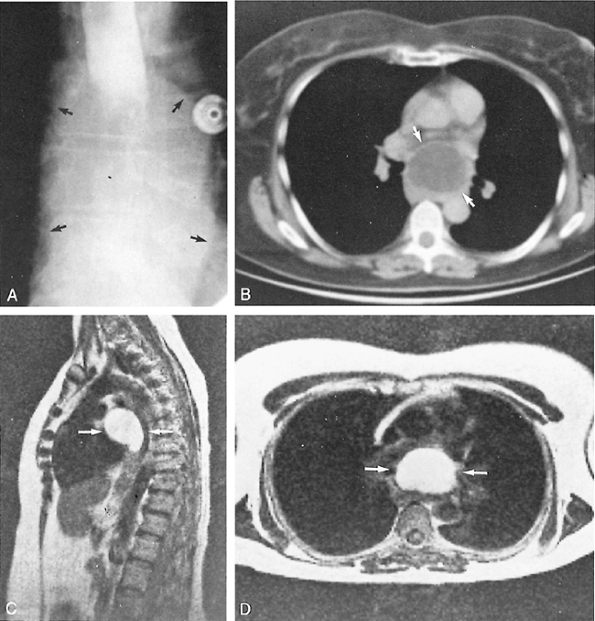 |
Fig. 195-12. Esophageal cyst in a 61-year-old woman. A. Barium swallow shows a soft tissue mass (arrows) compressing the midesophagus. B. Computed tomographic scan at the same level reveals obliteration of the esophagus by a thin-walled cystic (arrows) lesion. C. Magnetic resonance image in sagittal section of the chest reveals the mass (arrows) in the visceral compartment showing its high intensity because of its fluid content. D. Cross-sectional magnetic resonance image of mass (arrows). |
Treatment and Prognosis
The preferred treatment of an esophageal cyst is complete surgical excision. The approach is identical to the planning of surgery described for bronchogenic cysts. Duplication cysts may be embedded totally within the
P.2841
esophageal wall and may require either incision or possibly excision of the esophageal muscularis in continuity with the cyst. No communication usually exists between the cyst and the esophageal lumen, but excision may result in a partially myectomized esophageal body. Mucosal injury should be avoided. If it occurs, appropriate repair is mandatory. The muscularis, when a simple myotomy was required, should then be closed without undue narrowing of the esophageal lumen. In some patients in whom part of the muscularis has to be resected with the cyst, integrity of the esophageal mucosa is ascertained and the muscularis is left open to avoid an iatrogenic structure.
If the cyst extends into the abdomen, a thoracoabdominal approach should be used. In the only case seen in this series, the diagnosis of infradiaphragmatic extension was not made preoperatively and a separate laparotomy had to be performed to resect the tail end of the cyst.
Although surgical resection of the esophagus and the associated cyst has been reported to be successful, it is to be avoided because of the more common and serious early and late complications of resection of the esophagus, as contrasted to the minimal problems after simple excision of a cyst.
Recurrence may occur with only partial excision or simple aspiration. With complete excision, the prognosis is excellent.
TRACHEOESOPHAGEAL CYSTS
Abel (1956) described mediastinal cysts with mixed features of both bronchogenic and esophageal cysts. He suggested that these rare cysts result from tracheoesophageal fistulae that close off and become an isolated cystic structure during early embryogenesis. If they exist at all, these cysts are only pathologic curiosities. They are managed, if discovered, as either a bronchogenic or an esophageal cyst, depending on their location.
REFERENCES
Abel MR: Mediastinal cysts. Arch Pathol 61:360,1956.
Amendola MA, et al: Transdiaphragmatic bronchopulmonary foregut anomaly: Dumbbell bronchogenic cyst. AJR 138:1165, 1982.
Anderson AL, et al: Acute bronchogenic cyst formation: diagnosis by two-dimensional echocardiography. J Clin Ultrasound 10:444, 1982.
Anderson MC, Silberman WW, Shields TW: Duplication of the alimentary tract in the adult. Arch Surg 85:94, 1962.
Bennheim J, et al: Mediastinal leiomyosarcoma in the wall of a bronchogenic cyst [Letter]. Arch Pathol Lab Med 104:221, 1980.
Berkowitz KA, Fleischman JK, Smith RL: Bronchogenic cyst causing a unilateral ventilation-perfusion defect on lung scan. Chest 93:1292, 1988.
Bonavina L, et al: Mediastinal cyst involving the oesophagus: diagnosis and results of surgical treatment. Eur J Surg 162:703, 1996.
Buddington WT: Intradiaphragmatic cyst, ninth reported case. N Engl J Med 257:613, 1957.
Cohn JR, et al: Resolution of a mediastinal cyst by transtracheal needle aspiration. Pa Med 90:64, 1987.
Coselli MP, et al: Bronchogenic cysts above and below the diaphragm: report of eight cases. Ann Thorac Surg 44:491, 1987.
Coulson WF: Surgical Pathology. Philadelphia: JP Lippincott, 1978.
Demmy TL, et al: Multicenter VATS experience with mediastinal tumors. Ann Thorac Surg 66:187, 1998.
Dubois P, B langer R, Wellington JL: Bronchogenic cyst presenting as a supraclavicular mass. Can J Surg 24:530, 1981.
Estrera AS, Landay MJ, Pass LJ: Mediastinal carinal bronchogenic cyst: is its mere presence an indication for surgical excision? South Med J 80: 1523, 1987.
Ginsberg RJ, Atkins RW, Paulson DL: A bronchogenic cyst successfully treated by mediastinoscopy. Ann Thorac Surg 13:266, 1972.
Gomes MN, Hufnagel CA: Intrapericardial bronchogenic cysts. Am J Cardiol 36:817, 1975.
Greenfield LJ, Howe JS: Bronchial adenoma within the wall of a bronchogenic cyst. J Thorac Cardiovasc Surg 49:398, 1965.
Jost RG, et al: Computed tomography of the thorax. Radiology 126:125, 1978.
Kanemitsu Y, et al: Clinical features and management of bronchogenic cysts: report of 17 cases. Surg Today 29:1201, 1999.
K nig R, Herold U: Kernspintomographischen Nachweis einer mediastinalen bronchogenen Zyste. Radiologe 26:464, 1986.
LeBlanc J, et al: Imaging of mediastinal foregut cysts. Can Assoc Radiol J 45:381, 1994.
Lewis RJ, Caccavale RJ, Sisler GE: Imaged thoracoscopic surgery: a new technique for resection of mediastinal cysts. Ann Thorac Surg 53:318, 1992.
Lim LL, Ho KY, Goh PM: Preoperative diagnosis of a paraesophageal bronchogenic cyst using endosonography. Ann Thorac Surg 73:633, 2002.
Lupetin AR, Dash N: MRI appearance of esophageal duplication cyst. Gastrointest Radiol 12:7, 1987.
Magnussen JR, Thompson JN, Dickinson JT: Presternal bronchogenic cysts. Arch Otolaryngol 103:52, 1977.
Maier HC: Bronchogenic cysts of mediastinum. Ann Surg 127:476, 1948.
Marchevsky AM, Kaneko M: Surgical Pathology of the Mediastinum. New York: Raven, 1984.
Martinod E, et al: Thoracoscopic excision of mediastinal bronchogenic cysts: results in 20 cases. Ann Thorac Surg 69:1525, 2000.
Mendelson DS, et al: Bronchogenic cysts with high CT numbers. AJR 140: 463, 1983.
Miller DC, et al: Recurrent mediastinal bronchogenic cyst. Cause of bronchial obstruction and compression of superior vena cava and pulmonary artery. Chest 74:218, 1978.
Miller RF, Graub M, Pashuk ET: Bronchogenic cysts: anomalies resulting from maldevelopment of premature foregut and mid gut. Am J Roentgenol Rad Ther Med 70:771, 1953.
Moor J, Jahnke E: Mediastinal gastric cyst. J Dis Child 94:192, 1957.
Murley GD, Lenz TR: Bronchogenic cyst, intra-abdominal. Rocky Mt Med J 76:243, 1979.
Nakata H. et al: Computer tomography of mediastinal bronchogenic cysts. J Comput Assist Tomogr 6:733, 1982.
Oldham HN Jr, Sabiston DC Jr: Primary tumors and cysts of the mediastinum. Monogr Surg Sci 4:243, 1967.
Overton RC, Oberstreet JW: Peptic bronchitis: case report of mediastinal gastrogenic cyst with bronchial communication. Am Surg 24:964, 1958.
Reed JC, Sobonya RE: Morphologic analysis of foregut cysts in the thorax. AJR 120:851, 1974.
Rosai J: Ackerman's Surgical Pathology. St. Louis: CV Mosby, 1989.
Salyer DC, Salyer WR, Eggleston JC: Benign developmental cysts of the mediastinum. Arch Pathol Lab Med 101:136, 1977.
Selke AC Jr, Belin RP, Durnin R: Bronchogenic cyst in association with hypoplasia of the left pulmonary artery. J Pediatr Surg 10:541, 1975.
Silverman NA, Sabiston DC Jr: Mediastinal masses. Surg Clin North Am 60:757, 1980.
Singh S, et al: Squamous cell carcinoma arising from a congenital duplication cyst of the esophagus in a young adult. Dis Esoph 14:258, 2001.
Sirivella S, et al: Foregut cysts of the mediastinum. Results in 20 consecutive surgically treated cases. J Thorac Cardiovasc Surg 90:776, 1985.
Spock A, Schneider S, Baylin J: Mediastinal gastric cysts: a case report and review of English literature. Am Rev Respir Dis 94:97, 1966.
Sternberg SS: Diagnostic Surgical Pathology. New York: Raven, 1989.
St-Georges R, et al: Clinical spectrum of bronchogenic cysts of the mediastinum and lung in the adult. Ann Thorac Surg 52:6, 1991.
P.2842
Sulzer J, et al: Quarante kystes bronchog niques du m diastin. Consid rations topographiques. Ann Chir Thorac Cardiovasc 9:261, 1970.
Sumiyoshi K, et al: Bronchogenic cyst in the abdomen. Virchows Arch [A] Pathol Anat Histopathol 408:93, 1985.
Volpi A, et al: Left atrial compression by a mediastinal bronchogenic cyst presenting with paroxysmal atrial fibrillation. Thorax 43:216, 1988.
Walker OM, Zumbro GL, Treasure RL: Bronchogenic cysts: problems in diagnosis and management. Thoraxchir Vask Chir 26:59, 1978.
Watson AJ, Chaudhary BA: Cardiac arrhythmias and abnormal chest roentgenogram. Bronchogenic cyst. Chest 92:335, 1987.
Watts WJ, Rotman HH, Patten GA: Pulmonary artery compression by a bronchogenic cyst simulating congenital pulmonary artery stenosis. Am J Cardiol 53:347, 1984.
Wychulis AR, et al: Surgical treatment of mediastinal tumors. A 40 year experience. J Thorac Cardiovasc Surg 62:379, 1971.
Yim AP: Video assisted thoracoscopic management of anterior mediastinal masses. Preliminary experience and results. Surg Endosc 9:1184, 1995.
Zimmer WD, et al: Mediastinal duplication cyst. Percutaneous aspiration and cystography for diagnosis and treatment. Chest 99:772, 1986.
EAN: 2147483647
Pages: 203